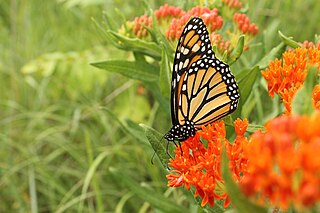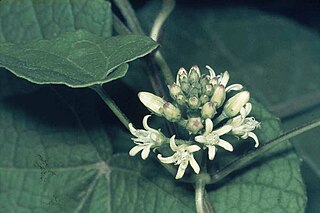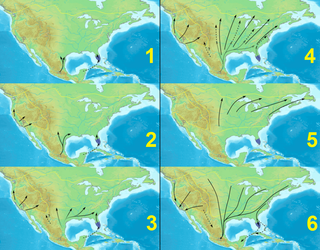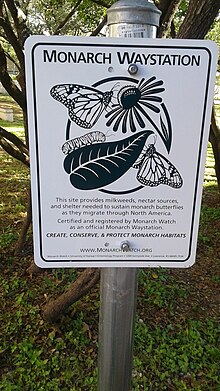
Asclepias tuberosa, commonly known as butterfly weed, is a species of milkweed native to eastern and southwestern North America. It is commonly known as butterfly weed because of the butterflies that are attracted to the plant by its color and its copious production of nectar.

The monarch butterfly or simply monarch is a milkweed butterfly in the family Nymphalidae. Other common names, depending on region, include milkweed, common tiger, wanderer, and black-veined brown. It is among the most familiar of North American butterflies and an iconic pollinator, although it is not an especially effective pollinator of milkweeds. Its wings feature an easily recognizable black, orange, and white pattern, with a wingspan of 8.9–10.2 cm (3.5–4.0 in). A Müllerian mimic, the viceroy butterfly, is similar in color and pattern, but is markedly smaller and has an extra black stripe across each hindwing.

Asclepias is a genus of herbaceous, perennial, flowering plants known as milkweeds, named for their latex, a milky substance containing cardiac glycosides termed cardenolides, exuded where cells are damaged. Most species are toxic to humans and many other species, primarily due to the presence of cardenolides. However, as with many such plants, some species feed upon them or from them. The most notable of them is the monarch butterfly, which uses and requires certain milkweeds as host plants for their larvae.

The Xerces Society for Invertebrate Conservation is a non-profit environmental organization that focuses on the conservation of invertebrates considered to be essential to biological diversity and ecosystem health. It is named in honor of an extinct California butterfly, the Xerces blue.

Asclepias syriaca, commonly called common milkweed, butterfly flower, silkweed, silky swallow-wort, and Virginia silkweed, is a species of flowering plant. It is native to southern Canada and much of the United States east of the Rocky Mountains, excluding the drier parts of the prairies. It is in the genus Asclepias, the milkweeds. It grows in sandy soils as well as other kinds of soils in sunny areas.

Asclepias incarnata, the swamp milkweed, rose milkweed, rose milkflower, swamp silkweed, or white Indian hemp, is a herbaceous perennial plant species native to North America. It grows in damp through wet soils and also is cultivated as a garden plant for its flowers, which attract butterflies and other pollinators with nectar. Like most other milkweeds, it has latex containing toxic chemicals, a characteristic that repels insects and other herbivorous animals.

Butterfly gardening is a way to create, improve, and maintain habitat for lepidopterans including butterflies, skippers, and moths. Butterflies have four distinct life stages—egg, larva, chrysalis, and adult. In order to support and sustain butterfly populations, an ideal butterfly garden contains habitat for each life stage.

Asclepias curassavica, commonly known as tropical milkweed, is a flowering plant species of the milkweed genus, Asclepias. It is native to the American tropics and has a pantropical distribution as an introduced species. Other common names include bloodflower or blood flower, cotton bush, hierba de la cucaracha, Mexican butterfly weed, redhead, scarlet milkweed, and wild ipecacuanha.

Asclepias fascicularis is a species of milkweed known by the common names narrowleaf milkweed and Mexican whorled milkweed. It is a perennial herb that grows in a variety of habitats.

Asclepias speciosa is a milky-sapped perennial plant in the dogbane family (Apocynaceae), known commonly as the showy milkweed and is found in the western half of North America.

The Native Plant Society of Texas is a Texas not-for-profit conservation organization that promotes the "conservation, research and utilization of the native plants and plant habitats of Texas through education, outreach and example".

Cynanchum laeve is a vining perennial herb native to eastern and central U.S. states and Ontario. Common names include sand vine, honeyvine, honeyvine milkweed, bluevine milkweed, climbing milkweed, and smooth swallow-wort. The root system of C. laeve can cause it to be very difficult to eradicate, especially in agricultural fields. It is a larval food of monarch butterflies and milkweed tussock moth larvae. C. laeve can cause eye irritation if touched and can be toxic to humans and livestock if consumed in large quantities.

Many populations of Lepidoptera migrate, sometimes long distances, to and from areas which are only suitable for part of the year. Lepidopterans migrate on all continents except Antarctica, including from or within subtropical and tropical areas. By migrating, these species can avoid unfavorable circumstances, including weather, food shortage, or over-population. In some lepidopteran species, all individuals migrate; in others, only some migrate.

Asclepias meadii is a rare species of milkweed known by the common name Mead's milkweed. It is native to the American Midwest, where it was probably once quite widespread in the tallgrass prairie. Today much of the Midwest has been fragmented and claimed for agriculture, and the remaining prairie habitat is degraded.

Asclepias viridis is a species of milkweed, a plant in the dogbane family known by the common names green milkweed, green antelopehorn and spider milkweed. The Latin word viridis means green. The plant is native to the midwestern, south central and southeastern United States, as well as to the southeastern portion of the western United States.

Monarch butterfly migration is the phenomenon, mainly across North America, where the subspecies Danaus plexippus plexippus migrates each summer and autumn to and from overwintering sites on the West Coast of California or mountainous sites in Central Mexico. Other subspecies perform minor migrations or none at all. This massive movement of butterflies has been called "one of the most spectacular natural phenomena in the world".
The U.S. state of California has instituted numerous conservation programs, policies, laws, reserves and Habitat restoration projects throughout the state to facilitate the health and migration of the western population of the monarch butterfly. The population of western monarchs require very different breeding and overwintering habitat when compared to the eastern population of monarch butterflies. They require specific micro-climatic conditions to survive the winter and they are sensitive to habitat changes at the overwintering sites. The large aggregations of butterflies are seen as the most vulnerable at their overwintering locations along the coast. Many monarch overwintering sites are contained within the "coastal zone"; an area defined by the Coastal Zone Management Act to be 1000 yards inland from the high tide mark. Large number of overwintering sites are outside the coastal zone. There are more than 450 overwintering sites in California.

Karen Suzanne Oberhauser is an American conservation biologist who specializies in monarch butterflies.

Churchville Nature Center is a facility of the Bucks County, Pennsylvania Department of Parks and Recreation and is located in Churchville, Pennsylvania. The center focuses on environmental education, public outreach and the preservation of native wildlife through its wide range of programs, projects and surveys. The nature center offers educational programing year round through its Environmental Education and Lenape Village departments. The center features a native butterfly house and covers 55 acres of wildlife preserve.

Asclepias angustifolia, commonly called the Arizona milkweed, is an endemic species of milkweed native only to Arizona.






















